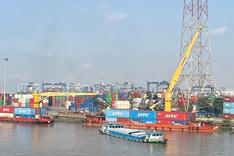
State Bank of Vietnam (SBV) Deputy Governor Pham Thanh Ha.
Facing mounting global risks and uncertainties, the State Bank of Vietnam (SBV) will maintain a proactive, flexible, and effective monetary policy aligned with fiscal and macroeconomic measures to stabilise inflation and support economic growth, according to the State Bank of Vietnam (SBV) Deputy Governor Pham Thanh Ha.
Speaking on 8 July, Ha noted that the United States had announced new tariffs of 25 to 40 per cent on imports from 14 countries, effective from 1 August, with the possibility of further increases if retaliatory measures are imposed. While global inflation is trending toward target levels, the risk of resurgence remains, he warned.
These developments are placing increased pressure on Vietnam’s monetary policy, particularly in managing exchange rates and interest rates, and in achieving the country’s economic growth target of 8 per cent or higher for 2025.
The SBV has directed credit institutions to cut operating costs, accelerate digital transformation, and adopt IT solutions to reduce lending rates. It will continue to manage exchange rates flexibly in line with market dynamics, while deploying monetary tools to ensure foreign exchange stability, which is essential for controlling inflation and maintaining macroeconomic balance.
Credit growth will be closely tied to macroeconomic conditions, inflation trends, and capital absorption capacity. Lending will be steered toward production, business, priority sectors, and industries that drive growth, with enhanced monitoring of high-risk areas.
The SBV also plans to advance the 2021–2025 restructuring plan for credit institutions and continue addressing non-performing loans (NPLs). Measures are being intensified to prevent the formation of new bad debts, and regulations on cashless payments and banking innovation through the sandbox mechanism are being implemented.
As of June 2025, total credit stood at over VND 17.2 quadrillion (approximately USD 658.43 billion), up 9.9 per cent from the end of 2024 and 19.32 per cent year-on-year, the highest growth rate since 2023, reflecting a strong recovery in key sectors such as manufacturing and agriculture.
Pham Chi Quang, Director of the SBV’s Monetary Policy Department, noted that credit growth in the first half of 2025 was 2.5 times higher than in the same period of 2024, providing significant support to the economy. With a 2025 inflation target of around 4.5 per cent, higher than in 2024, the SBV has room to expand credit without undermining price stability.
Quang stressed that credit expansion must be accompanied by quality control, NPL oversight, and systemic risk management. Restructuring credit institutions remains a central objective in 2025.
On 3 January, the SBV instructed commercial banks to implement the credit programme under Government Resolution 33/NQ-CP, focusing on social housing, worker housing, and old apartment renovation.
Loans under this scheme are not subject to the SBV’s annual credit growth quotas. Effective through 2030, the programme sets lending limits based on registered levels of participating banks.
Current interest rates are 6.4 per cent per annum for developers and 5.9 per cent for homebuyers, 0.2 percentage points lower than the previous period, and significantly down from the original rates of 8.7 and 8.2 per cent, respectively.
By the end of May, banks had disbursed a total of VND 4.09 trillion (approximately USD 156.6 million), including VND 3.46 trillion to developers across 27 projects and VND 630 billion to homebuyers in 25 projects.




















